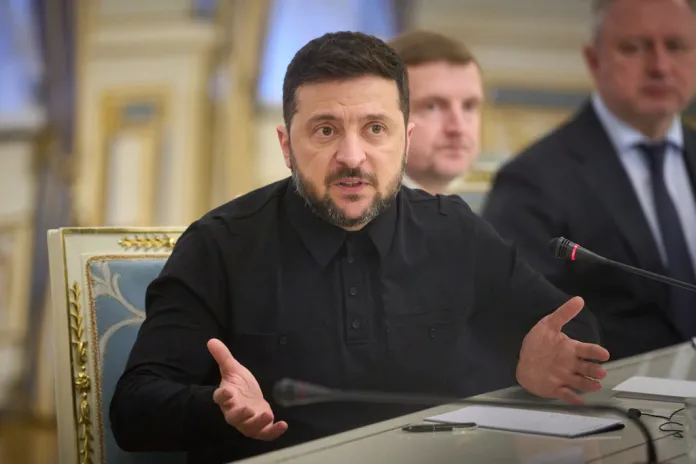Blackouts envelop Ukraine as Russia targets energy infrastructure
The article reports on a significant Russian missile adn drone strike targeting Ukraine’s energy infrastructure, plunging large parts of the contry into blackout. Over the night from Thursday to Friday, Russia deployed a massive combined assault using advanced drones, hypersonic missiles, ballistic missiles, and cruise missiles, with Ukraine’s Air Force reporting 465 drones and 32 missiles involved. The attacks primarily hit energy facilities across central and eastern Ukraine, including major cities like Kyiv, Kharkiv, and Donetsk, damaging hydroelectric and thermal power plants.
Ukrainian officials described the strike as one of the largest and most focused on energy infrastructure, causing severe disruptions such as cutting off water to millions, including 2 million residents in Kyiv. President Zelensky condemned the attack as a calculated effort to undermine civilian life ahead of winter and called for increased international support.
Russia has intensified these strikes every fall and winter since 2022 to demoralize Ukraine and disrupt logistics. This year’s campaign is notably more potent due to Russia’s enhanced missile and drone capabilities and weakened Ukrainian air defenses. The strikes have severely damaged Ukraine’s natural gas refineries, forcing Kyiv to seek costly imports, mainly from the United States, to prepare for the winter heating season. The situation raises concerns over Ukraine’s ability to maintain energy supplies through the upcoming harsh winter.
Blackouts envelop Ukraine as Russia targets energy infrastructure
Russia launched one of its most concentrated strikes of the war against Ukraine‘s energy infrastructure, plunging much of the country into darkness.
Over the night on Thursday into Friday, Russia launched a combined missile and drone assault, using its upgraded Geran drones, Kinzhal hypersonic missiles, Iskander ballistic missiles, and cruise missiles. Ukraine’s Air Force said the attack consisted of 465 kamikaze and decoy drones and 32 missiles. Though eclipsed in size by other, larger attacks in preceding weeks, the attack was one of Russia’s largest, primarily targeting energy infrastructure. Drone and missile strikes over the past few months have mainly targeted military, industrial, and logistical targets.
Ukrainian Prime Minister Yulia Svyrydenko described the assault as “one of the largest concentrated strikes” of the war against Ukraine’s infrastructure.
Drones and missiles hit energy targets in central and eastern Ukraine, including in Kyiv, Chernihiv, Kharkiv, Poltava, Zaporizhzhia, Sumy, Kherson, Dnipropetrovsk, and Donetsk oblasts. Hydroelectric and thermal power plants were devastated by the attacks.
Videos posted on social media showed missiles and drones hitting power stations, setting off large flashes of blue before whole cities went dark.
The energy impact was severe enough to cut off water to millions of Ukrainians, including 2 million people in Kyiv, according to Deputy Prime Minister Oleksiy Kuleba. Work on repairs began immediately.
“It was a cynical and calculated attack, with more than 450 drones and over thirty missiles targeting everything that sustains normal life, everything the Russians want to deprive us of,” Ukrainian President Volodymyr Zelensky wrote on X.
“It is precisely the civilian and energy infrastructure that is the main target of Russia’s strikes ahead of the heating season. Together, we can protect people from this terror,” he added, pleading for more help internationally.
Russia began its first campaign targeting Ukrainian energy infrastructure in the fall of 2022, intending to demoralize the Ukrainian population and disrupt the country’s logistics. It has launched similar campaigns every fall and winter since, but this time around could be the most effective due to Moscow’s increased drone and missile capabilities and Kyiv’s degraded air defenses.
Many Russian analysts interpreted the intensified strikes as retaliation for Kyiv’s drone campaign against energy infrastructure within Russia. Strikes on refineries have resulted in gas shortages across the country, Kyiv’s first success in months. The attacks appeared to be a major reason why President Donald Trump shifted his tune on the war, as he believes Ukraine’s chances are more favorable than previously.
Russia has responded in earnest. In a single wave of strikes against the Poltava and Kharkiv oblasts, Russian drones and missiles wiped out 60% of Ukraine’s natural gas refineries, people familiar with the matter told Bloomberg. Kyiv now believes it will have to purchase 4.4 billion cubic meters of natural gas to make up the difference, largely from the United States. Ukrainian officials reportedly estimated that the cash-strapped country would need to spend roughly $2.2 billion on natural gas imports to make it through the winter.
WAR IN UKRAINE CAUSING GLOBAL TNT SHORTAGE
Ukrainians rely almost entirely on natural gas to heat their homes in the harsh winters.
Ukraine has been able to make it through the past three wartime winters due to its air defenses and quick repairs of the energy grid. Russia’s increased capabilities and Ukraine’s reduced air defenses, as illustrated by the last two rounds of attacks, suggest that this may be much more challenging in the war’s fourth winter.
" Conservative News Daily does not always share or support the views and opinions expressed here; they are just those of the writer."




